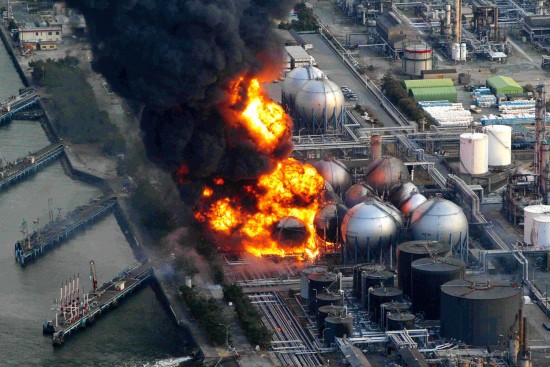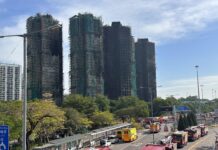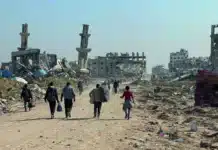Former Prime Minister says government was on verge of evacuating 50 million people and declaring martial law
Dikang, chinaworker.info
The nuclear disaster at the Fukushima Daiichi plant in March 2011 was the second worst nuclear disaster ever, after the 1986 Chernobyl disaster in Ukraine. Some scientists warn that Fukushima’s destructive effects may even be even worse than Chernobyl. At Chernobyl there was a meltdown in one reactor, while at Fukushima three of six reactors suffered explosions and meltdown. This followed the powerful Tohoku earthquake and tsunami of 11 March 2011, which killed almost 16,000 people. The huge tsunami knocked out the Fukushima nuclear plant’s electrical supply and water cooling systems, causing the fuel elements in the reactor cores to melt.
The Fukushima site contains a lot more nuclear material (over 1,700 tons) than Chernobyl did (180 tons). Both Chernobyl and Fukushima were ranked ‘level 7’ on an international scale of nuclear incidents, although the Japanese government initially understated the crisis – citing ‘level 4’ on the so-called INES scale – something that was immediately challenged by foreign experts.
In the years that have passed the government and the plant’s owner, Tepco, which is the largest privately owned power company in the world, have been massively criticised for their bungled response, safety lapses, denials and cover-ups. Naoto Kan, who was Prime Minister when the disaster struck, has admitted that Japan came very close to complete disaster with the government discussing the evacuation of 50 million people, including the capital Tokyo, and declaring martial law. “Something on that scale, an evacuation of 50 million, it would have been like a losing a huge war,” Kan told the UK Telegraph newspaper (4 March 2016). In the interview, Kan recalls that he got “no clear information” out of Tepco, and that the government’s main nuclear safety adviser Nobuaki Terasaka was clueless over what to do.
In 2012 an independent investigation led by Dr Kiyoshi Kurokawa concluded the Fukushima disaster was “man made”. Since 2006, based on study at that time, Japan’s nuclear regulator and Tepco knew that a total electrical outage could occur if the plant was hit by a major tsunami. Tepco took no action and the regulator was aware of this but also failed to take action. The report from Kurokawa’s committee accuses the government and its regulatory agencies of “collusion” with the nuclear power industry, which Kurokawa says “have formed a lobby so powerful that its actions have been largely untouched by the nation’s regulations.” The report also blasts the government’s decision to allow Tepco to handle the ‘clean up’ operation, which it mishandled spectacularly, resulting in the government eventually taking over the process in 2013.
More than 160,000 people have been evacuated from the area around Fukushima. Many of these areas have suffered economic collapse in addition to environmental destruction. The right-wing government of Shinzo Abe plans to end the evacuation orders in March next year and use economic pressure – ending compensation payments – to get the Fukushima refugees to return.
Decommissioning the crippled Fukushima plant will take at least 40 years. Estimates of the cost vary from 100 billion to 250 billion US dollars. This cost of course doesn’t include the longer-term threat posed by leaks of radioactive material into the environment.
Pacific contamination
“Fukushima is the sea version of Chernobyl,” as one Japanese blogger put it. Tepco has been struggling to deal with the growing volume of water it uses to cool the damaged reactors. This water becomes highly radioactive and must be stored in gigantic containers, as tall as a 3-storey house, which are only a temporary solution. The newspaper Asahi Shimbun recently published a photo showing that the number of these giant tanks has reached over 1,100. The storage tanks were constructed by low-paid contract labour, without following legal requirements, raising further safety concerns. Several radioactive leaks have occurred of highly contaminated water into the Pacific Ocean in 2013 and again in 2014.
In addition to incidents involving the storage tanks, lower-level contaminated groundwater that washes down from the mountains behind the Fukushima plant and through its foundations, runs into the Pacific Ocean at the rate of 300 tonnes per day. There it moves with the currents and is carried by marine life that absorb the radiation. The consequences of all this for the ocean and its ecosystems is now a major global concern.

Workers abused
The largely untold story of the Fukushima disaster is the appalling price paid by workers involved in the ‘clean up’ operation. In 2011, following the disaster, Tepco cut the pay of its own workforce by 20 percent as it sought a financial bailout from the government. Around 12,000 workers are involved in the struggle to bring the Fukushima site under control and most of these are contract labourers employed by a vast number of subcontractors. In the wider evacuation zone up to 45,000 workers are engaged on similarly precarious terms in clearing debris from the disaster. Among them are many homeless people ‘recruited’ by the Yakuza or Japanese Mafia, who run or have links with the subcontractors. The gangs have been used to ‘solve’ a labour shortage. According to Japanese police around 50 Yakuza gangs operate in the Fukushima prefecture.
“Tepco sits atop a pyramid of subcontractors that can run to seven or more layers,” noted a report by Reuters, based on interviews with several of the Fukushima workers. This is despite the fact that such arrangements using ‘third-party brokers’ are illegal in Japan. The Reuters report found that wages for these workers was about a third lower than the average in the construction industry.
Cover up
Independent journalists and experts accuse the Japanese government and Tepco of staging a cover up to keep the Japanese people in the dark. This spans every aspect of the disaster from the number of worker deaths to the safety of locally grown food. Because food from the Fukushima area – previously one of Japan’s richest farming regions – is unsellable, local authorities have ordered it to be used in school lunches. This has sparked protests from parents and teachers.
Officially only three workers have died during the Fukushima clean up operation. But independent reporter Mako Oshidori says the real figure is much higher because official reports only count workers who die on the job. Many more have died at home following a period of illness related to radiation exposure.
Despite the terrible incalculable costs of Fukushima, the multibillion-dollar nuclear industry and many governments are pushing ahead with nuclear expansion plans. Nowhere is this more the case than in Asia, where 40 new nuclear plants are under construction and 100 more are planned. The countries targeting the biggest increase in nuclear power are China, South Korea and India.
Toxic politics
Abe’s government has restarted three nuclear reactors in the past year and is committed to restarting all Japan’s 50 reactors shut down since the 2011 disaster. This issue runs very deep in the only country to be attacked by nuclear weapons. Recent years have seen many huge anti-nuclear protests. Polls have shown up to 60 percent are opposed to restarting any of Japan’s nuclear reactors. This is despite the government’s attempts to manipulate public opinion and a 20 percent rise in household electricity bills since the disaster.
A nuclear-free future requires a plan for massive investment in safe and renewable alternatives. This is linked to the need for a socialist alternative to today’s established political parties. Pro-capitalist politicians inevitably bow to the dictates of the big capitalist corporations with their addiction to short-term profits.
Socialists and the CWI welcome the anti-nuclear protest movements that have swept Japan and other parts of Asia, while we also stress the need for these movements to offer a programme against capitalism. Only by replacing the anarchic ‘market’ with a system of democratic socialist planning based on public ownership can society develop the huge potential of renewable energy (such as wind and solar power) and thereby shift the world’s energy and climate policies onto a safe trajectory.




